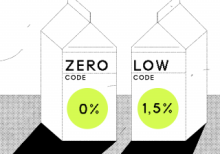Low-code and no-code solutions are becoming popular to business as they seek to simplify their development processes and reduce costs. Low-code and no-code solutions offer businesses the ability to quickly develop and deploy applications without the need for a team of developers or a lengthy process. These platforms can reduce costs in time and materials as well as licensing and infrastructure. Low-code and no-code platforms can make integrating other systems easier.
From a business perspective low-code and no-code solutions can lower IT costs, supporting operations, introduce agility needed when customer demand and market environments change. There is a compelling argument for low-code and no-coded solutions supporting strategic business objectives.
What do low-code and no-code solutions not do? They do not remove the need for technical support. Skill sets able to work with these platforms are in demand and do not come cheap. They do not bring flexibility. If the business has a highly specialized workflow low-code and no-code platforms will not be as beneficial. In this case highly specialized workflow is defined as any workflow with more than 100 rules.
Let’s look at cost scenarios for three popular low-code and no-code platforms.
First SalesForce. At around 1M dollars per instance the business will need complex work flows and integrations as well as a lot of users to justify the purchase. Specialized skills will also be needed to maintain and develop on the platform. There is a Small Business version of SF. For the most part it has the features of many free CRM products and not particularly competitive in that space. Not likely to be a consideration for most organizations so since we are looking at average businesses SF look like a fit.
Next Microsoft Power Apps comes into consideration. Taking into account monthly subscription plans and pay as you go plans, the average price came in at about $10 user/app/month for an average of 5 apps per user based on the recommended number of apps employees should be using for max productivity as discovered in the Harmonie survey, https://harmonie.cdn.prismic.io/harmonie/9a7b0ee2-0a05-49aa-94a0-90fb2e771334_app-survey-report-digital-sep2017.pdf . That averages out to about $50/month run rate for every employee. If we factor in a three year reserve the run rate can drop by about 50%. So $25/month for 5 apps per each employee. Seems pretty reasonable. Let’s look at the upfront costs. Mainly there will be a Power Apps developer at $200/hr. So for a SMB lets say it is a straight forward app and will take on average 20 hours for a data source and 20 fields. For each app the cost is $4000 plus licensing maybe. For a business to get 5 applications deployed they will have around $20K upfront and a $50 monthly expense per employee. Looks like a pretty reasonable option for many businesses.
Next for consideration is OutSystems. The platform is priced at $1500/month and needs a specialized skill set to develop applications. The platform is very versatile with many connectors available to easily integrate solutions with other systems. Much like SalesForce volume is where the return on investment is. The benefit is seen at around 100+ applications. So, most companies probably would not find value in the platform under its current licensing model and again since the scope of the post is looking at average businesses this probably will not be a fit.
To summarize, low-code and no-code platforms can reduce costs, but they have draw backs as well that need to be taken into account before deciding if low-code should be added to the organization’s technology roadmap.

